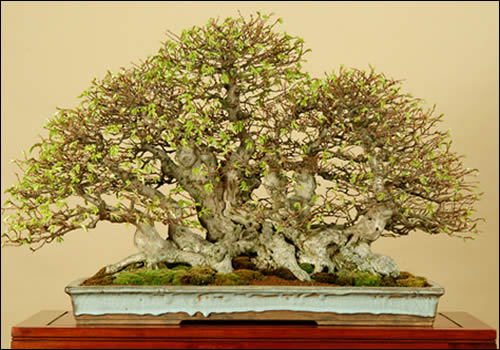Hornbeams are hardwood trees in the flowering plant genus Carpinus in the birch family Betulaceae.
Hornbeams are small to medium-sized trees. Two varieties being frequently used for bonsai, Carpinus betulus reaching a height of 32 m. and Carpinus turczaninowii, a smaller rounded deciduous tree with prominently veined ovate leaves, reddish when young and orange-tinted in autumn, and conspicuous fruiting raceme The leaves are deciduous, alternate, and simple with a serrated margin, and typically vary from 3 – 10 cm in length.
Not difficult to grow as bonsai; however the development rate is slow as they only produce one seasonal growth spurt per year under normal growing conditions. A very early spring combined with a long warm summer with more than usual humidity can sometimes produce two. For this reason never prune hard as you will not get fresh growth and could seriously harm the tree. Partial but never complete defoliation can be used to reduce leaf size, but if the conditions are not good it will cause dieback.
Subject to fungal infections and leaf spot; keep well ventilated, do not have moss covered soil and treat any infections with fungicide.



Carpinus turczaninowii: Korean hornbeam is a small rounded deciduous tree with prominently veined ovate leaves, reddish when young, orange-tinted in autumn and with conspicuous fruiting racemes.


Korean hornbeam leaves are smaller and more clearly veined.
As a species they are not difficult to grow as bonsai; they are very late to lose their leaves in autumn and often the withered leaves remain in place similar to beech, sometimes requiring gentle trimming to remove before the new shoots break out in spring.
